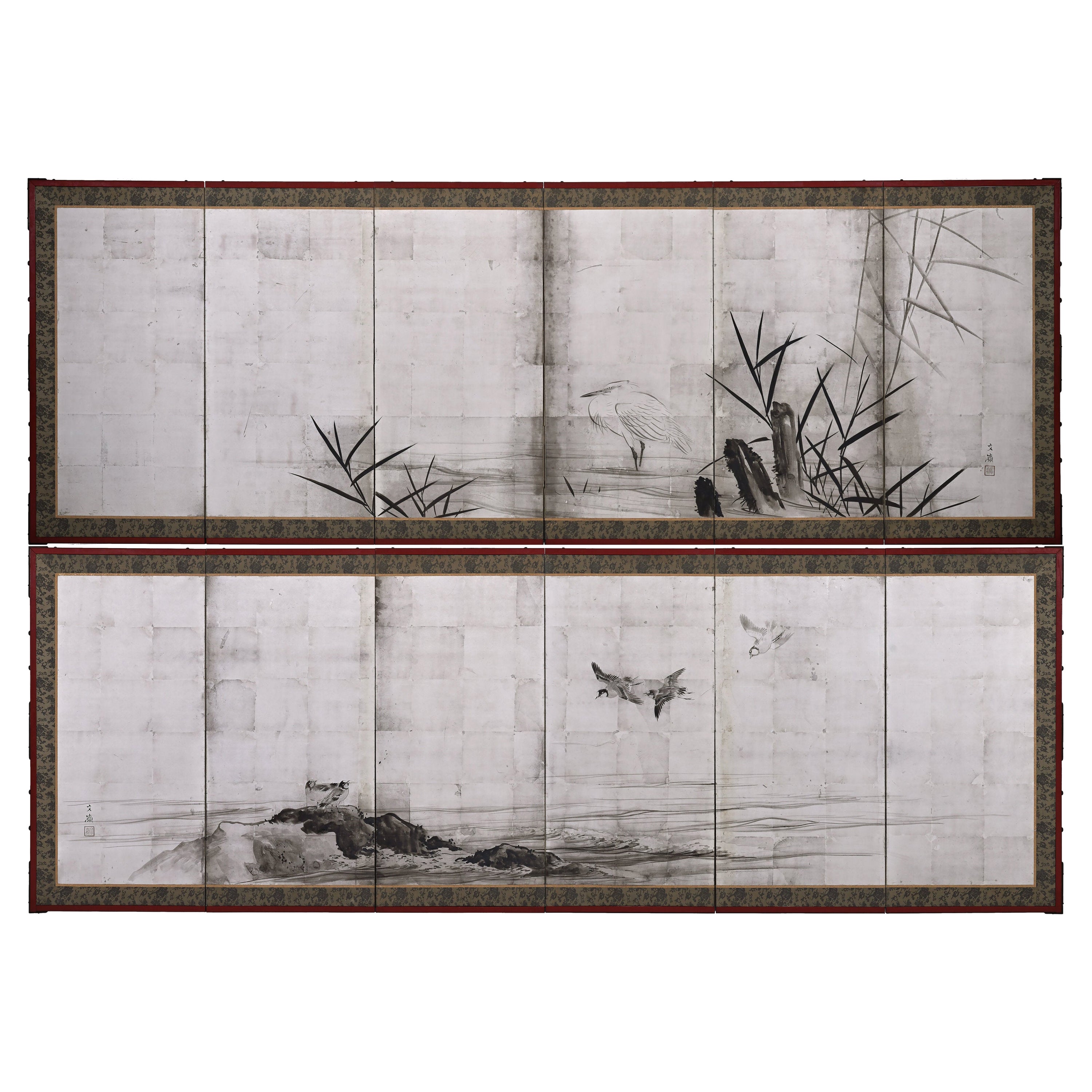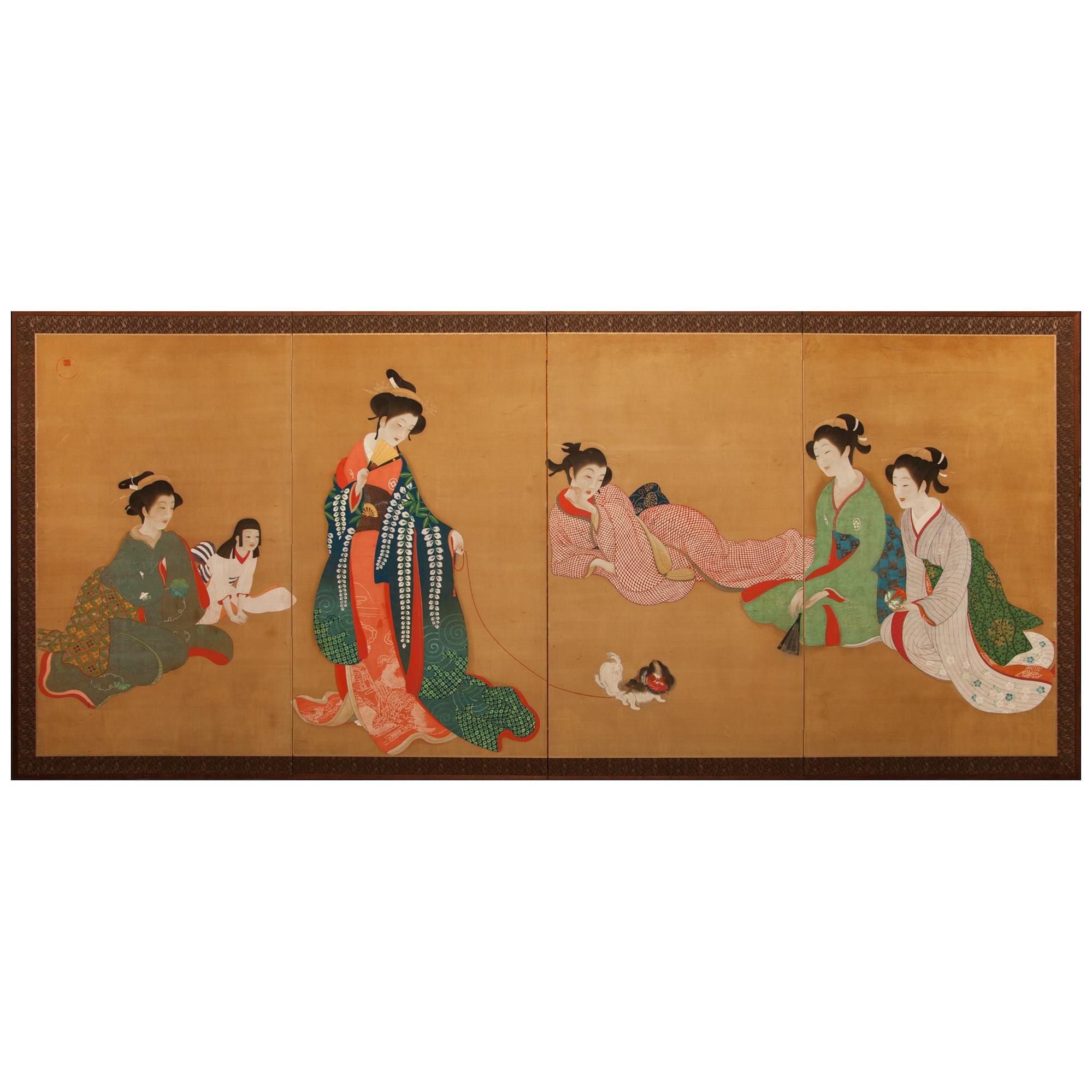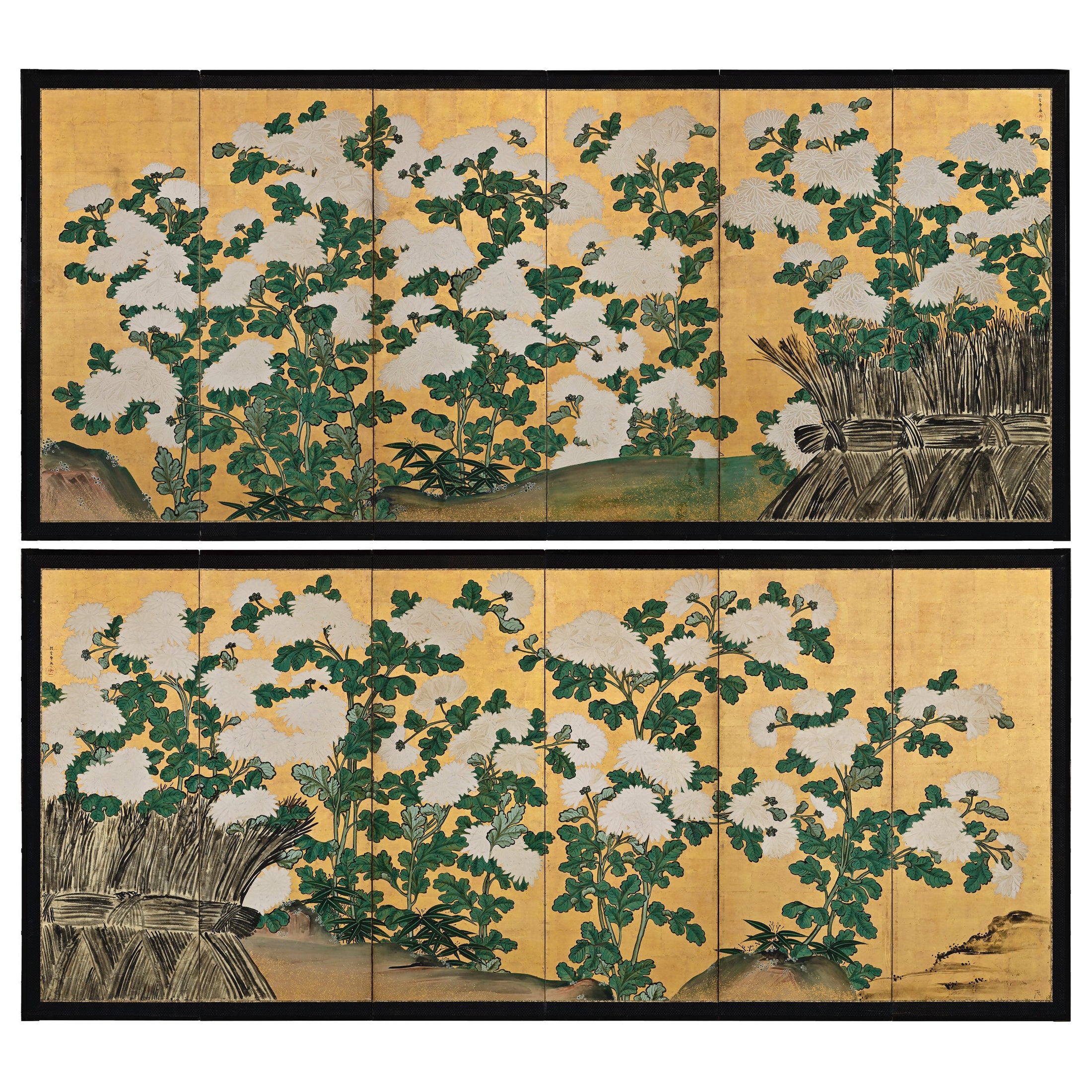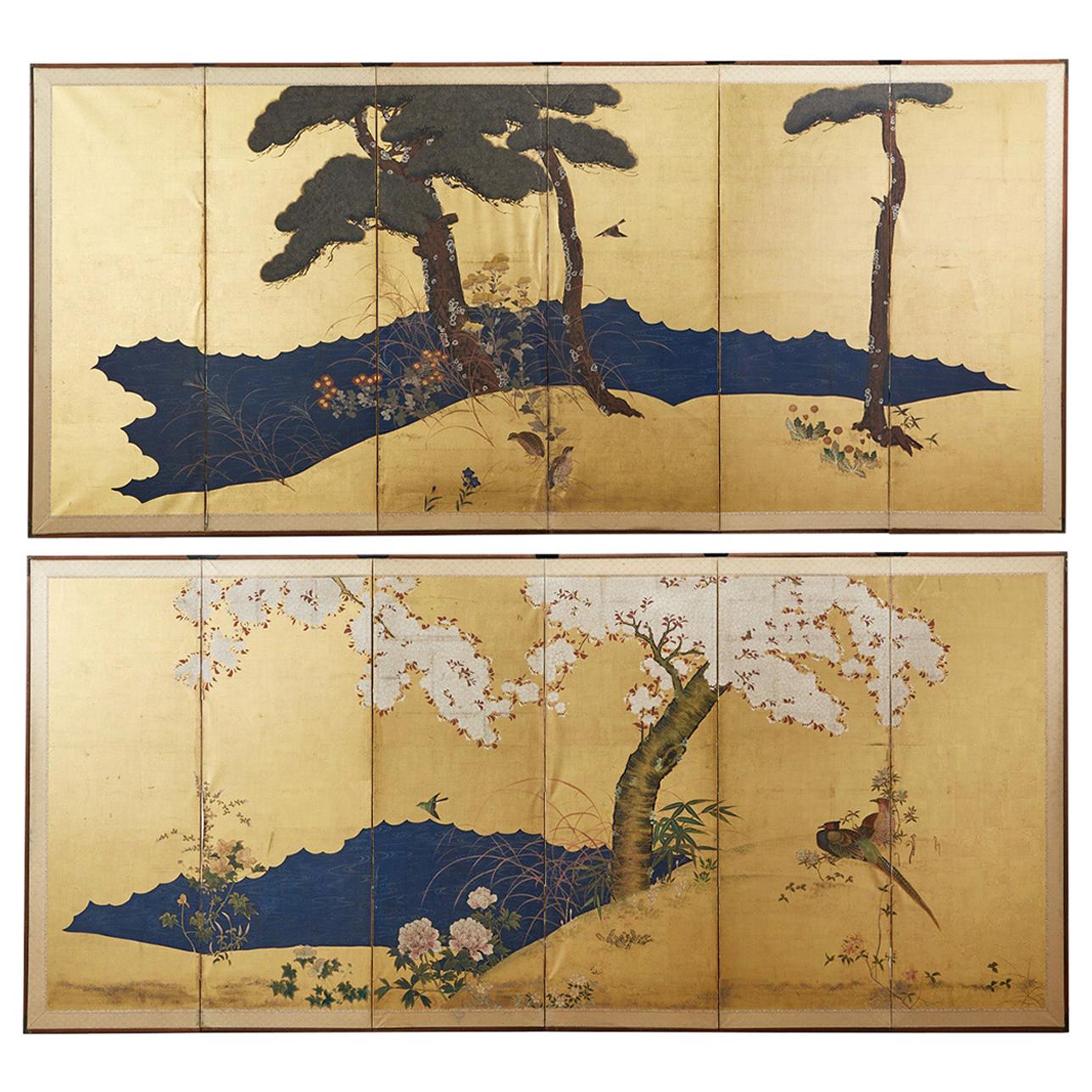Items Similar to Meiji Period Japanese Screen Pair, One Hundred Birds by Hasegawa Gyokujun
Want more images or videos?
Request additional images or videos from the seller
1 of 13
Meiji Period Japanese Screen Pair, One Hundred Birds by Hasegawa Gyokujun
About the Item
One hundred birds
Hasegawa Gyokujun (1863-1921)
Meiji period, circa 1900.
Ink, color and gofun on silk.
Dimensions of each screen:
H. 170 cm x W. 190 cm (67’’ x 75”)
Despite the title, well over 100 birds are represented in this pair of two-fold Japanese screens (the title functions figuratively to convey the idea of a large number). The monumental work is rendered with a comprehensive and highly complex composition which is exquisitely executed and meticulously colored. More a celebration of naturalism than the traditional “One Hundred Birds” paintings which originated in China. This was a subject matter known for its auspicious meaning as much as its actual depiction of nature. These paintings generally had a phoenix (occasionally peacocks) placed in the center, and the other birds paying homage to it.
In this quintessentially Japanese scene painted by Gyokujun, a couple of long-tailed birds modeled after paradise flycatchers are included; these are traditional auspicious motifs in Oriental bird and flower painting and denote themes such as celebration and enduring generations. In addition there is the playful inclusion of single exotic parrot. Even so, the vast majority of the birds and flowers are native to Japan. Reading the scene from right to left, from spring through to autumn, the overwhelming sense is one of movement and haste. It is almost as if the birds are in a race, with the fleetest leading the way forward. Although these native birds were commonly drawn amongst artists of the Shijo school, rarely were they painted with such drama and dynamism. It is not strictly a depiction of sketched birds whose manner was faithfully handed down through the traditions of the Shijo school. Rather we see Gyokujun seeking and achieving new expressions in the heart of the turbulent Meiji period.
Hasegawa Gyokujun (1863-1921) was born in Kyoto. He was the eldest son of Hasegawa Gyokuho, a Shijo school painter who studied under Matsumura Keibun. Gyokujun studied painting under his father and became a prominent member of the Kyoto painti
ng world from a young age. In 1891 he established the ‘Young Painters Social Club’ along with Takeuchi Seiho, Miyake Gogyo and Taniguchi Kokyo. Also in 1891 he was selected as a judge of the Great Private Paintings Exhibition along with Takeuchi Seiho, Yamamoto Shunkyo and Kikuchi Hobun. In addition he won prizes as several national and international expositions, including the Chicago Columbian World Fair (1893), the Fourth National Industrial Exhibition (1895), and the first exhibition of the Nihon Kaiga Kyokai (Japan Painting Association). He was a highly respected and promising artist though he disappeared from the painting world of Kyoto and served as an elementary school art teacher in Otsu.
- Dimensions:Height: 67 in (170.18 cm)Width: 75 in (190.5 cm)Depth: 0.75 in (1.91 cm)
- Sold As:Set of 2
- Style:Meiji (Of the Period)
- Materials and Techniques:
- Place of Origin:
- Period:1900-1909
- Date of Manufacture:circa 1900
- Condition:Wear consistent with age and use.
- Seller Location:Kyoto, JP
- Reference Number:1stDibs: LU2472331333822
About the Seller
5.0
Recognized Seller
These prestigious sellers are industry leaders and represent the highest echelon for item quality and design.
Gold Seller
These expertly vetted sellers are highly rated and consistently exceed customer expectations.
Established in 2001
1stDibs seller since 2016
59 sales on 1stDibs
Typical response time: 6 hours
- ShippingRetrieving quote...Ships From: Kyoto, Japan
- Return PolicyA return for this item may be initiated within 10 days of delivery.
More From This SellerView All
- Japanese Silver Screen Pair, Meiji Period, Herons & Plovers, Shijo SchoolLocated in Kyoto, JPHeron & Plovers Ink and silver leaf on paper Maekawa Bunrei (1837-1917) A pair of low six-panel Japanese screens by Maekawa Bunrei, a later master of the Kyoto based Shijo school of painting. On the right screen a solitary white heron stands motionless in a stream. On the left screen plovers play along a shoreline. The elegant forms are executed employing fluid, minimalistic ink brushstrokes. The soft brushstrokes and the sharp light of the silver leaf lend the scenes a sense of translucence. The sophisticated composition superbly exploits the long, horizontal pictorial surface of the pair of folding screens...Category
Antique Early 1900s Japanese Meiji Paintings and Screens
MaterialsSilver Leaf
- Meiji Era, Circa 1900 Japanese Screen Pair, Flowers & Birds of Spring & AutumnLocated in Kyoto, JPFlowers & Birds of Spring and Autumn Unknown artist. Japan. Meiji period, circa 1900. A pair of six-fold screens. Ink, color, gofun and gold leaf on paper. Signed: Gaga S...Category
Antique 1890s Japanese Meiji Paintings and Screens
MaterialsGold Leaf
- Mid-18th Century Japanese Screen Pair, One Hundred Flowers, ChrysanthemumsLocated in Kyoto, JPOmori Soun (b. 1704) Chrysanthemums - One Hundred Flowers A Pair of Six-fold Japanese Screens. Ink, color, gofun and gold leaf on paper. Dating ...Category
Antique Mid-18th Century Japanese Edo Paintings and Screens
MaterialsGold Leaf
- Japanese Screen Pair, Tigers by Kishi Renzan, Late Edo PeriodLocated in Kyoto, JPKishi Renzan (1804-1859) Tigers Pair of six-panel Japanese screens. Ink and gold-leaf on paper. In this monochromatic pair of six-fold Japanese screens painted on gold-leaf, Kishi Renzan has created a breathtaking composition of a family of tigers. The screens are filled with a sense of drama which is conveyed by both the subject matter and the wet, expressive brushwork. The running mountain stream and the towering waterfall allude to refreshment during the summer months and we feel the tiger families familiarity and security within their environment. Renzan’s master, Kishi Ganku...Category
Antique Mid-19th Century Asian Edo Paintings and Screens
MaterialsGold Leaf
- 19th Century Japanese Screen Pair. Flowers & Birds of the Four SeasonsLocated in Kyoto, JPFlowers & Birds of the Four Seasons Pair of six-fold Japanese Screens. Ink, color, gofun and gold on paper. Second half of the 19th Centur...Category
Antique Late 19th Century Japanese Meiji Paintings and Screens
MaterialsWood, Paper
- 17th Century Japanese Screen. Ink Plum Tree & Birds by Kano Naonobu.Located in Kyoto, JPKano Naonobu (1607-1650) Plum Tree and Birds Six-fold Japanese Screen. Ink and slight color on paper. In this evocative ink work spread over a six-panel folding screen, we see the consummation of the elegance and refinement of the Edo Kano school. This 17th century screen is a rare surviving example of a large-scale bird and flower painting by Kano Naonobu, the younger brother of Kano Tanyu...Category
Antique 17th Century Japanese Edo Paintings and Screens
MaterialsWood, Paper
You May Also Like
- Japanese Meiji Two Panel Screen Song Birds in SakuraLocated in Rio Vista, CAExceptional Japanese Meiji period two-panel screen, circa 1900. Featuring songbirds amid sakura cherry trees and flowering peony. Made in the Nihonga School style on handcrafted mulb...Category
20th Century Japanese Meiji Paintings and Screens
MaterialsBrass
- Meiji Period Japanese Four Panel Screen Bijin At LeisureLocated in Hudson, NYJapanese four panel screen: Bijin At Leisure. Ladies in a tea house with a small dog. Seal reads "Ensan dai" (drawn by Ensan). Meiji Period (1868 - 1912) pa...Category
Antique Late 19th Century Japanese Meiji Paintings and Screens
MaterialsSilk, Wood
- Pair of Japanese Meiji Six Panel Screens of Seasonal LandscapesLocated in Rio Vista, CAFascinating pair of large Japanese Meiji period six-panel screens of seasonal landscapes with flowers and birds. The first screen depicts a pair of pheasants in a spring landscape with a white flowering cherry tree, peonies, and rose of Sharon with brush clover. The second screen depicts a pair of quail in an autumn landscape with flowering autumn plants and grasses including chrysanthemums, bellflowers, and ominaeshi. The umbrella pines appear to be in the manner of Kano Tanyu...Category
Antique 19th Century Japanese Meiji Paintings and Screens
MaterialsBrass, Gold Leaf
- Japanese Meiji Two Panel Screen Geese and ReedsLocated in Rio Vista, CAFantastic Japanese late Meiji period two-panel byobu screen by Hashimoto Koshu. The large screen features two white geese amid brightly colored reeds. The symbolism of geese and reeds was introduced to Japan from China in the 13th century. This was a popular subject for Japanese zen artists of the period. Beautifully crafted with exceptional brush strokes and details. Made with natural pigments in dramatic vivid colors of white, pink, and mint green on a silk background of gilt. Circa 1900 with artist seal on bottom right corner. Koshu studied Western art under...Category
20th Century Japanese Meiji Paintings and Screens
MaterialsSilk, Wood, Paper
- Japanese Six-Panel Meiji Screen Flowering Peonies and ButterfliesLocated in Rio Vista, CAStunning Japanese Meiji period six-panel large screen. Featuring blooms of spring flowering white, pink, and red peonies with butterflies over a gilt background. Made in the Nihonga ...Category
20th Century Japanese Meiji Paintings and Screens
MaterialsBrass
- Meiji Era Japanese Two Panel Hand Painted Wood Table Screen Tale of GenjiLocated in Studio City, CAA Meiji era Japanese two-panel wood screen, with illustrated images from The Tale of Genji that are exquisitely painted directly on wood with fine detail and precision, accented with scattered 24k gold leaf specks in cloud forms, rendered in the manner of Heian period...Category
Antique 19th Century Japanese Meiji Paintings and Screens
MaterialsGold Leaf
Recently Viewed
View AllMore Ways To Browse
Japanes Birds
Japanese Birds
Industrial Japanese
Silk Bird
Silk Birds
Exposition 1900
Bird On Silk
Bird Silk Art
Japan Ink Wood
Japanese Screens Large
Japanese Painting With Birds
Meiji Pair
Antique Kyoto
Chinese Screen Circa
Asian Paintings Of Birds
Oriental Birds
Traditional Japanese Painting
Large Chinese Screens





